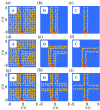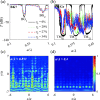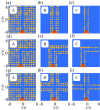Super strong wide TM Mie bandgaps tolerating disorders
- PMID: 35552455
- PMCID: PMC9098900
- DOI: 10.1038/s41598-022-11610-0
Super strong wide TM Mie bandgaps tolerating disorders
Abstract
This study demonstrates the appearance of super intense and wide Mie bandgaps in metamaterials composed of tellurium, germanium, and silicon rods in air that tolerate some disordering of rod position and rod radius under transverse magnetic (TM) polarized light waves. Tellurium metamaterials reveal [Formula: see text], [Formula: see text], [Formula: see text], [Formula: see text], [Formula: see text] Mie bandgap modes in which [Formula: see text], [Formula: see text], and [Formula: see text] tolerate high rod-position disordering of [Formula: see text] and rod-radius disordering of 34 and [Formula: see text], respectively. Results for germanium metamaterials show Mie bandgap modes [Formula: see text], [Formula: see text], and [Formula: see text], in which [Formula: see text] and [Formula: see text] tolerate rod-position disordering of [Formula: see text], and rod-radius disordering of 34 and [Formula: see text], respectively. Using these characteristics of [Formula: see text] in germanium metamaterials under position and radius disordering, ultra-narrow straight, L-shaped, and crossing waveguides that contain 14, four, and two rows of germanium rods in air are designed. Also, it is shown that [Formula: see text] Mie bandgap appears in metamaterials containing a high refractive index, and disappears in metamaterials with a lower refractive index such as silicon; in contrast, a new phenomenon of intense and broadband [Formula: see text], [Formula: see text], and [Formula: see text] in metamaterials with a lower refractive index such as silicon appear. In silicon-based metamaterials, [Formula: see text] tolerates high rod-position and rod-radius disordering of [Formula: see text] and [Formula: see text], respectively, and [Formula: see text] shows robustness to rod-position and rod-radius disordering of [Formula: see text]. This strong tolerance of disordering of TM modes in tellurium, germanium, and silicon metamaterials opens a new way to design small, high-efficient, and feasible fabrication optical devices for optical integrated circuits.
© 2022. The Author(s).
Conflict of interest statement
The authors declare no competing interests.
Figures










Similar articles
-
Towards Perfect Ultra-Broadband Absorbers, Ultra-Narrow Waveguides, and Ultra-Small Cavities at Optical Frequencies.Nanomaterials (Basel). 2022 Jun 21;12(13):2132. doi: 10.3390/nano12132132. Nanomaterials (Basel). 2022. PMID: 35807967 Free PMC article.
-
Ultra-narrow, highly efficient power splitters and waveguides that exploit the TE01 Mie-resonant bandgap.Opt Express. 2021 Oct 11;29(21):32951-32965. doi: 10.1364/OE.438980. Opt Express. 2021. PMID: 34809116
-
Temperature-resilient anapole modes associated with TE polarization in semiconductor nanowires.Sci Rep. 2022 Dec 9;12(1):21345. doi: 10.1038/s41598-022-25289-w. Sci Rep. 2022. PMID: 36494403 Free PMC article.
-
Thermo-optic tuning of silicon nitride microring resonators with low loss non-volatile [Formula: see text] phase change material.Sci Rep. 2022 Oct 24;12(1):17815. doi: 10.1038/s41598-022-21590-w. Sci Rep. 2022. PMID: 36280699 Free PMC article.
-
Electromagnetic surface waves supported by a resistive metasurface-covered metamaterial structure.Sci Rep. 2020 Sep 23;10(1):15548. doi: 10.1038/s41598-020-72396-7. Sci Rep. 2020. PMID: 32968140 Free PMC article.
Cited by
-
Towards Perfect Ultra-Broadband Absorbers, Ultra-Narrow Waveguides, and Ultra-Small Cavities at Optical Frequencies.Nanomaterials (Basel). 2022 Jun 21;12(13):2132. doi: 10.3390/nano12132132. Nanomaterials (Basel). 2022. PMID: 35807967 Free PMC article.
References
-
- Perera T, Gunapala SD, Stockman MI, Premaratne M. Plasmonic properties of metallic nanoshells in the quantum limit: From single particle excitations to plasmons. J. Phys. Chem. C. 2020;124:27694–27708. doi: 10.1021/acs.jpcc.0c10507. - DOI
-
- Garcĩa-Garcĩa I, et al. Silver-based plasmonic catalysts for carbon dioxide reduction. ACS Sustain. Chem. Eng. 2020;8:1879–1887. doi: 10.1021/acssuschemeng.9b06146. - DOI
Grants and funding
LinkOut - more resources
Full Text Sources

